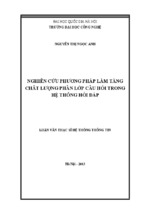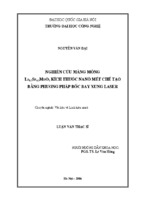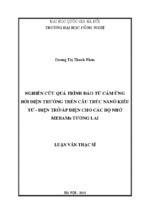VIETNAM NATIONAL UNIVERSITY, HANOI
UNIVERSITY OF LANGUAGES AND INTERNATIONAL STUDIES
FACULTY OF POST-GRADUATE STUDIES
*********
NGUYỄN THỊ HOÀI THU
INTEGRATING PRONUNCIATION ELEMENTS INTO LISTENING
LESSONS FOR FIRST YEAR NON ENGLISH MAJOR STUDENTS
AT HANOI UNIVERSITY OF INDUSTRY
(KẾT HỢP DẠY CÁC YẾU TỐ NGỮ ÂM TRONG GIỜ HỌC NGHE
CHO SINH VIÊN NĂM THỨ NHẤT KHÔNG CHUYÊN
TRƯỜNG ĐẠI HỌC CÔNG NGHIỆP HÀ NỘI)
M.A. MINOR PROGRAMME THESIS
Field: English Teaching Methodology
Code: 60140111
Hanoi, 2015
VIETNAM NATIONAL UNIVERSITY, HANOI
UNIVERSITY OF LANGUAGES AND INTERNATIONAL STUDIES
FACULTY OF POST-GRADUATE STUDIES
*********
NGUYỄN THỊ HOÀI THU
INTEGRATING PRONUNCIATION ELEMENTS INTO LISTENING
LESSONS FOR FIRST YEAR NON ENGLISH MAJOR STUDENTS
AT HANOI UNIVERSITY OF INDUSTRY
(KẾT HỢP DẠY CÁC YẾU TỐ NGỮ ÂM TRONG GIỜ HỌC NGHE
CHO SINH VIÊN NĂM THỨ NHẤT KHÔNG CHUYÊN
TRƯỜNG ĐẠI HỌC CÔNG NGHIỆP HÀ NỘI)
M.A. MINOR PROGRAMME THESIS
Field: English Teaching Methodology
Code: 60140111
Supervisor: Hoàng Thị Xuân Hoa, Ph.D
Hanoi, 2015
DECLERATION
I declare that this thesis and the work presented in it are my own and have been generated
by me as the result of my own original research.
I confirm that this thesis is submitted in partial fulfillment of the requirement for the
degree of Master of Arts and that this thesis has not previously been submitted for a degree
or any other qualification at any other universities or institutions.
Hanoi, August, 2015
Nguyễn Thị Hoài Thu
i
ACKNOWLEDMENTS
First and foremost, I would like to take this opportunity to express my deep sense of
gratitude and indebtedness to my supervisor Hoàng Thị Xuân Hoa, Ph.D for her
extraordinary help, valuable advice and outstanding support.
Secondly, my special thanks go to all the teachers in the faculty of Post Graduate Studies,
University of Languages and International Studies for their useful lectures, materials,
guidance and enthusiasm during my course.
I also highly appreciate the cooperation of my students in class CK2.2- K9 at Hanoi
University of Industry, without them this thesis would not be at all possible.
Finally, my grateful thanks and gratitude extend to my family and my friend, who have
always encouraged me and supported me to fulfill this study.
ii
ABSTRACT
Proper pronunciation makes significant contribution to successful communication. Despite
its importance, it is often ignored and neglected in EFL classes. The study involves an
action research on integrating pronunciation elements into listening lessons. However,
since pronunciation comprises a variety of elements, in this study, the researcher just
concentrates on intonation teaching. The aim of this study is to investigate how integrating
intonation teaching into listening lessons improves students’ intonation and students'
attitudes toward the teaching method. The participants were 45 first year non English
major students at Hanoi University of Industry. The treatment was conducted in eight
weeks with eight intonation lessons which were integrated in the post-listening stage of the
listening lessons. The major source of data for the research came from two sets of
instruments including tests and questionnaire. The results of the study show that after the
treatment, students’ intonation significantly improved and the majority of them had
positive attitude toward intonation and the teaching method. Therefore, it can be said that
the intonation teaching integrated with listening lessons helped to improve the students’
intonation.
iii
TABLE OF CONTENTS
Declaration .......................................................................................................................... i
Acknowledgments ............................................................................................................. ii
Abstract ............................................................................................................................. iii
List of abbreviations.......................................................................................................... vi
List of tables ...................................................................................................................... vi
List of figures .................................................................................................................... vi
List of charts...................................................................................................................... vi
CHAPTER 1: INTRODUCTION ................................................................................... 1
1.1. RATIONALE OF THE STUDY ....................................................................................... 1
1.2. AIMS AND OBJECTIVES OF THE STUDY ...................................................................... 3
1.3. RESEARCH QUESTIONS ............................................................................................. 3
1.4. SCOPE OF THE STUDY................................................................................................ 4
1.5. SIGNIFICANCE OF THE STUDY ................................................................................... 4
1.6. ORGANIZATION OF THE STUDY ................................................................................. 4
CHAPTER 2: LITERATURE REVIEW....................................................................... 5
2.1. PRONUNCIATION IN TEACHING AND LEARNING ENGLISH AS A SECOND LANGUAGE . 5
2.1.1. The importance of pronunciation and pronunciation teaching ........................ 5
2.1.2 Pronunciation elements ..................................................................................... 6
2.2. INTONATION IN THE ENGLISH LANGUAGE ................................................................ 8
2.2.1. Definition of intonation ..................................................................................... 8
2.2.2. System of intonation .......................................................................................... 9
2.2.3. Tone unit ......................................................................................................... 13
2.2.4. Functions of intonation ................................................................................... 14
2.2.5 The importance of intonation ........................................................................... 16
2.3 APPROACHES TO TEACH PRONUNCIATION ............................................................... 17
2.3.1 Bottom-up and top-down approaches .............................................................. 17
2.3.2 Intuitive-imitative and analytic-linguistic approaches .................................... 17
2.3.3 Integrated approach......................................................................................... 18
2.3.4 Integrating teaching intonation into listening ................................................. 18
2.4 SUMMARY ............................................................................................................... 20
iv
CHAPTER 3: METHODOLOGY................................................................................ 21
3.1. THE CONTEXT OF THE STUDY ................................................................................. 21
3.2. SUBJECTS................................................................................................................ 22
3.3. THE ACTION RESEARCH PROJECT ............................................................................ 22
3.3.1 Action research ................................................................................................ 22
3.3.2 Action research procedure ............................................................................... 24
3.4 SUMMARY ............................................................................................................... 27
CHAPTER 4: RESULTS AND DISCUSSIONS ......................................................... 29
4.1. RESULTS FROM THE TESTS ...................................................................................... 29
4.1.1 Results from the pre-test .................................................................................. 29
4.1.2 Results from the pre-test and four progress tests............................................. 30
4.1.3 Results from the pre-test and post- tests .......................................................... 32
4.1.4 Discussion of the test results ............................................................................ 33
4.2 RESULTS FROM THE STUDENTS’ QUESTIONNAIRE .................................................... 34
4.2.1 Attitude toward studying English intonation ................................................... 34
4.2.2 Attitude toward the integrated approach of learning intonation ..................... 35
4.2.3 Other opinions.................................................................................................. 36
4.2.4 DISCUSSION OF THE QUESTIONNAIRE RESULTS ..................................................... 37
4.3 SPECIFY LEARNING .................................................................................................. 37
CHAPTER 5: CONCLUSION ...................................................................................... 39
5.1 MAJOR FINDINGS AND IMPLICATIONS ...................................................................... 39
5.2 LIMITATIONS OF THE STUDY .................................................................................... 40
5.3 RECOMMENDATIONS FOR FUTURE RESEARCH ......................................................... 40
5.4 CONCLUSION ........................................................................................................... 40
REFERENCES ............................................................................................................... 41
APPENDICES…. ............................................................................................................. I
v
LIST OF ABBREVIATIONS
EFL
:
English as a Foreign Language
ESL
:
English as a Second Language
HaUI
:
Hanoi University of Industry
LIST OF TABLES
Table 1: Results from the pre-test ………………………………………………
28
Table 2: Comparison of the scores of the pre-test and progress tests…………...
30
Table 3: Comparison of the scores of the pre-test and post-test ……………….
31
LIST OF FIGURES
Figure 1: Features of English pronunciation …………………………………..
6
Figure 2: Detailed action research model………………………………………
23
LIST OF CHARTS
Chart 1: Student's mean sores in pre-test and progress tests …………………..
29
Chart 2: Attitude toward studying English intonation ………………………… 33
Chart 3: Attitude toward the integrated approach……………………………… 34
vi
CHAPTER 1: INTRODUCTION
1.1. Rationale of the study
English is regarded as the main language of international communication. Good
communication in English depends considerably on the proper pronunciation. In other
words, pronunciation is considered the bridge through which the message is delivered;
proper and correct pronunciation is the soul of comfortable and successful communication.
Moreover, good pronunciation is considered to be more essential than perfect knowledge
of grammar. It is believed that a learner with poor pronunciation is less likely to be
understood than a learner who makes many mistakes in grammar.
When dealing with pronunciation, it is necessary to mention two main features of
pronunciation- the segmental and suprasegmental features. Segmental features are sets of
distinctive sounds of particular language and the suprasemental features are related to
intonation; stress and change of sounds in connected speech. In this study, the researcher
just focuses on intonation since it is an essential part of pronunciation. Furthermore,
intonation is very important for communication as it helps the addressee interpret the
message. Intonation choices made by speakers carry linguistic information and the various
elements of intonation are seen to perform a variety of functions.
Despite the significance of pronunciation as well as intonation, it is complained that
pronunciation including intonation have often been ignored and received little explicit
focus in the ESL classes (Griffiths, 2011; Woolard, 1993). A lot of English teachers seem
to feel uncomfortable with intonation and they tend to treat it as a difficult subject:
difficult to isolate, difficult to describe, and difficult to formulate rules. In the context of
Vietnam, pronunciation along with intonation is still neglected or ignored at many
universities and colleges. It is mostly taught in separated lessons or by traditional
approaches such as top-down approach, bottom-up approach, intuitive-imitative approach
and analytic-linguistic approach. However, with those traditional approaches, the English
pronunciation teaching and learning seem to be not as effective as expectation.
1
Like many universities in Vietnam, Hanoi University of Industry (HaUI) considers English
as a necessary skill beside other professional skills which the students should be welltrained. In order to help the students be able to communicate in English, the course
syllabus is designed with general objectives to get the learner to be mastered in oral
communication. The main content of syllabus focuses on improving students’ listening
and speaking skill. However, as my observation during two years teaching here, the poor
pronunciation is the big challenge for students to master those skills. Many teachers
complain that improper pronunciation leads students in being unconfident in speaking and
confused with listening comprehension. For two years working with non-English major
students at HaUI, the researcher recognizes that a large number of them mispronounce
separated words and words combined in a sentence. Other pronounces a sentence with
equal stress, flat intonation and no rhythm at all. Especially, with the flat intonation,
students speak English like reading their script. There was almost no emotion, no change
in pitch when they are speaking. Consequently, it is difficult to understand their
expressions and thoughts that go with words. In addition, with the limited knowledge of
intonation, many students have difficulty in understanding and interpreting speakers’
expression in listening tasks. For instance, if a positive sentence is spoken with the rising
tone, the speaker has tendency to put a query rather than make a statement. However, the
students hardly understand clearly speaker’s purpose so they generally give incorrect
answer.
Since pronunciation is the most complicated aspect of language to obtain, most English
teachers, especially non-native speakers like at HaUI, feel unconfident in teaching
pronunciation. Furthermore, because of some reasons such as the shortage of instructions
or guidance dealing with pronunciation in textbooks, too few pronunciation exercises as
well as the lack of time, teachers at HaUI often ignore pronunciation teaching. Therefore,
teaching pronunciation by integrating it into other lessons is suggested.
As Morley
(1991:486) stated “the need for the integration of pronunciation with oral communication
was soon realized with a shift from specific linguistic competencies to broader
communicative competencies as goals for both the teacher and the learner”. In this study,
2
the researcher decided to integrate pronunciation elements into listening lessons because
the conversations in listening tasks can be good models for students to imitate.
For the reasons above, it is necessary to do an action research on: “Integrating
pronunciation elements into listening lessons for first year Non English major students at
Hanoi University of Industry”. However, as pronunciation comprises a lot of elements, the
research just concentrates on teaching intonation with the hope that students can improve
their intonation for communicative purpose.
1.2. Aims and objectives of the study
The research is conducted with the aims at:
-
Improving students’ intonation by integrating intonation teaching into listening
lessons.
-
Investigating students’ attitudes toward integrating intonation teaching into
listening lessons.
Besides the main aim at finding out how integrating intonation teaching into listening
lessons improves students’ intonation, the researcher investigates students’ attitudes
toward the teaching method because it is an important factor that influences learners’
studying results. Moreover, understanding students’ attitudes helps the teacher to adjust
lesson plans for more effective intonation teaching and learning.
1.3. Research questions
In order to fulfill the above aims, the research is designed to seek the answers of the two
following questions:
-
To what extent does integrating intonation teaching into listening lessons improve
students’ intonation?
-
What are the student’s attitudes toward integrating intonation teaching into
listening lesson?
3
1.4. Scope of the study
This is an action research with a focused group of 45 first year Non English major students
at Hanoi University of Industry. There are a great number of pronunciation elements;
however, this study just focuses on intonation. The researcher integrates teaching
intonation into listening lessons with the aim at improving students’ intonation.
1.5. Significance of the study
Firstly, the study is conducted with the hope to help the students who participated in this
project improve their English intonation. Secondly, this research can be an interesting
reference material for EFL teachers, especially English teachers at HaUI about the ways
how to integrate intonation teaching into listening lessons. Lastly, the research may make
contribution to the overall literature picture of teaching intonation integrated into listening
lessons in Vietnamese context.
1.6. Organization of the study
The thesis is instructed in five chapters.
Chapter 1 includes rationale, the objectives, research questions, the scope, the significance
and the organization of the study.
Chapter 2 provides a review of the literature on the approaches to pronunciation teaching
as well as intonation teaching.
Chapter 3 presents the research methodology.
Chapter 4 presents the results of the study, along with analysis and discussion of the data.
Chapter 5 offers a summary of the findings of the study, conclusion, limitations and
suggestion for future research.
4
CHAPTER 2: LITERATURE REVIEW
2.1. Pronunciation in teaching and learning English as a second language
2.1.1. The importance of pronunciation and pronunciation teaching
Many linguists (Yates, 2002; Kelly, 2000) share the viewpoint that pronunciation plays an
important role in second language teaching and learning. Without it, learners have many
difficulties
in
Misunderstanding,
getting
their
speech
communication
understood
breakdown
or
and
failure
understanding
may
occur
others’.
due
to
mispronunciation. When mentioning about the importance of pronunciation, Hewings
(2004:11) claims “difficulties with pronunciation might mean that students fail to get their
message across, even when the correct words are being used, or they may fail to
understand what is said to them”. In other words, problematic pronunciation possibly
prevents ESL learners expressing their thoughts clearly and comprehending others’
speech. To some extent agreeing with Hewings, Kelly (2000) also states that a learner who
consistently mispronounces a range of phonemes can be extremely difficult for a speaker
from another language community to understand. This can be very frustrating for the
learner who may have a good command of grammar and lexis but have difficulty in
understanding and being understood by a native speaker.
Mastering grammar, having a good knowledge of vocabulary, being able to read and write
well are all parts of learning a language. However, not being able to pronounce words
hugely hinders communication, especially since it is believed that, learners who are unable
to pronounce words are also unable to understand them. This means that teaching
pronunciation is an important area which should be dealt with regularly. Harmer (2001)
also argues convincingly that it is thanks to pronunciation teaching that students not only
become aware of different sounds and sound features, but can also improve their speaking
immeasurably. Subsequently, he claims that (Harmer, 2001:183) “concentrating on
sounds, showing where they are made in the mouth, making students aware of where
words should be stressed – all these things give them extra information about spoken
English and help them achieve the goal of improved comprehension and intelligibility”
5
Without question, pronunciation is an inseparable aspect of the language which has a great
influence on our successful communication. Intelligible pronunciation is essential during a
listening process, clear and correct pronunciation makes a conversation more comfortable
for both the speaker and the listener and even helps to avoid misunderstanding.
2.1.2 Pronunciation elements
Pronunciation involves features at the segmental level and suprasegmental level. The
figure that is shown below expresses the main features of pronunciation according to
Pourhosein (2012:120).
Figure 1. Features of English pronunciation
Segmental features: segmental aspects of the sound system include individual vowels and
consonants. Segmental features relate to sounds at the micro level. They include specific
sounds within words (for example, l as in lamp, r as in ramp, a as in hat).
Phonemes: The sound systems of consonants, vowels or their combinations are called
phonemes. Phonemes are sounds that, when pronounced incorrectly, can change the
meaning of the word. Compare the changes of meaning in: pet- pat, lamp- ramp.
6
Consonants are sounds in which there is obstruction to the flow of air as it passes from the
larynx to the lips. Consonant sounds can be voiced (a part of the mouth is closed and the
air behind it is released suddenly – for example, v as in van, b as in bun) - or unvoiced (air
is pushed through a narrow part of the mouth – for example, f as in fan, th as in thin).
Vowels are sounds in which there is no obstruction to the flow of air as it passes from the
larynx to the lips. Vowel sounds are articulated as single sounds. They can be short (for
example, æ as in cat) or long (ɑ: as in cart). Diphthongs are two vowel sounds put together
(for example, eɪ as in Kate or as in boy).
Suprasegmental features relate to sounds at the macro level. Linking, intonation and
stress are important features for effective pronunciation at the suprasegmental level.
Linking refers to the way the last sound of one word is joined to the first sound of the next
word. To produce connected speech, words are run together to link consonant to vowel,
consonant to consonant, and vowel to vowel. Some sounds are also shortened and others
are left out altogether.
Word stress relates to the greater prominence or loudness given to a particular syllable in
a word. For example: conDItion, JOYful (The syllables indicated in capitals are stressed
ones).
Sentence stress relates to the prominence given to certain words in an utterance. These
focus words are stressed (made long and loud) to convey the overall rhythm of the
utterance and the most meaningful part of the utterance. At the meaning level, some words
are given more prominence than others to foreground which meaning is important. For
example, compare:
Can YOU take the scissors? (not someone else)
Can you take the SCISSORS? (not the knife)
Intonation can be thought of as the melody of the language – the way the voice goes up
and down according to the context and meanings of the communication. For example, note
the differences in:
7
Can you take the scissors? (rising pitch) – request
Can you take the scissors (falling pitch) – command
It is worthy to say that intonation is a key component of pronunciation. It is an important
factor to get speaker to express s/he thought easily and listener to interpret speech
accurately. Improper intonation is likely to be causing a breakdown in communication. In
this study, the researcher just focuses on intonation teaching instead of all pronunciation
elements.
2.2. Intonation in the English language
2.2.1. Definition of intonation
Intonation is defined in different ways by other linguists. Intonation has been characterized
as “the rising and falling of the voice to various pitch levels during the articulation of an
utterance” (Celce-Murcia, et al., 1996:184) or, more simply, “the pitch pattern in a
sentence” (Ladefoged, 2006:23). To a certain extent sharing the same content with the
above definitions, Kelly (2000:86) indicates that “the term intonation refers to the way the
voice goes up and down in pitch when we are speaking.”
From the words of those linguists, it is clear to see that pitch is the common thread running
through most descriptions. Intonation, then, can be narrowly described as “the movements
or variations in pitch to which we are attached familiar labels describing levels (e.g. highlow) and tones (e.g. falling-rising), etc.” (Higuchi, 2002:1). Or it can be broadly defined as
“systematic variations in pitch level, pitch movement and prominence.” (Higuchi, 2002:1).
The terms "intonation" and "pitch" are often used interchangeably when talking about the
"highness" or "lowness" of our voice when we speak. The difference between the terms is
not very significant; in short, intonation is the use of pitch and it is a broader term than
pitch. Being able to perceive pitch (the highness of lowness of voice) leads to the use of
correct intonation.
For purposes of this paper, the definition of intonation in Longman Dictionary of
Language Teaching and Applied Linguistics (1992:190) will be adopted
8
“when speaking, people generally raise and lower the pitch of their voice, forming
pitch patterns. They also give some syllables in their utterance a greater degree of
loudness and change their speech rhythm. These phenomena are called intonation.
Intonation does not happen at random but has definite patterns which can be
analyzed according to their structure and functions. Intonation is used to carry
information over and above that which is expressed by the word in the sentence.”
Obliviously, intonation cannot be defined in separation from pitch variation, stress and
speech rhythm. In other words, they are key elements forming three systems of English
intonation namely tone, tonicity, and tonality. Furthermore, it can be seen from the
definition that English intonation has its own structure and functions. The discussion of
system, structure, and function of English intonation will be made in the following parts of
the research.
2.2.2. System of intonation
English intonation comprises “three separated, though related, systems: tonality
(intonation units), tonicity (the tone syllables) and the tone (pitch movements) (Tech,
1996:73)
2.2.2.1 Tonality
According to Tench (2006:6) “the discourse – any discourse – will be segmented into a
sequence of units of information (unless there is only one unit). This segmentation is
called tonality”. Spoken discourse may consist of a whole text, a sentence, one word or
even only one syllable. Furthermore, Tech points out that tonality holds a unit of
information. The information is ‘encoded’ in units of grammar. Clause is the most obvious
unit of grammar so a unit of intonation coincides with a whole clause or a significant
element of clause structure. Clause is designed to convey a typical piece of information.
Subject and predicates are two main components of clauses and predicates have verbs
which are either followed by a complement or a direct object and possibly an indirect
object or even by no kind of object at all. The design of any clause represents our
9
perception of a happening or situation- one piece of information. Clause is pronounced as
a single unit of intonation.
2.2.2.2 Tonicity
Tonicity is the location of the most prominent word (or even syllable) in each intonation
unit and causes a significant movement of pitch. The most prominent word/syllable is
called the tonic (or “nucleus”) and it usually occurs as the final lexical item in the
intonation unit (Tech, 2006). System of tonicity is the range of choices in the position that
the tonic syllable can have in a given intonation units. Tonicity or tonic syllable is the
focal point of intonation, the heart of an intonation unit, so it is the tonic syllable that is the
compulsory part of each intonation unit. The tonic syllable plays a very important role in
the utterance because when the speakers put the prominence on any particular syllable, the
hearers can percept what new information is. “Its function is to indicate what is new and
what is not new information in each intonation unit is.” (Tech, 2006:7)
2.2.2.3 Tone
The third system in the organization of information is tone. The term ‘tone’ refers to the
pitch movement that begins in the tonic syllable. Tone handles the matters: primary and
secondary information, ‘dependent’ information and implied and highlighted information.
Roach (1983:113) identifies tone as “a unit of speech bounded by pauses has movement,
of music and rhythm, associated with the pitch of voice”. This certain pattern of voice
movement is called “tone”. A tone is a certain pattern, not an arbitrary one, because it is
meaningful in discourse. By means of tones, speakers signal whether to refer, proclaim,
agree, disagree, question or hesitate, or indicate completion and continuation of turntaking, in speech.
Each linguist has their own classifications of English tones. Crystal (1969) and Ladefoged
(1982) identify four basic tones (fall, rise-fall, rise, and fail-rise) while O'Connor and
Arnold (1973) distinguish only two (rise and fall). In the context of this study, five tones
identified by Roach (1983) are chosen to teach for the students.
10
Fall (
)
A falling tone is by far the most common used tone of all. A speaker, by choosing a falling
tone, also indicates to the addressee that that is all he has to say, and offers a chance (turntaking) to the addressee to comment on, agree or disagree with, or add to his utterance.
However, it is up to the addressee to do either of these. Overall, the fall could be said to
give an impression of “finality”.
For example, if someone ask a question and replies “ yes” or “no” with the fall tone, it will
be understood that question is now answered and there is nothing more to be said.
A falling tone may be used in referring expressions. E.g: I love your SMILE.
Questions that begin with wh-questions are generally pronounced with a falling tone. E.g:
Whose is this DICtionay?
Imperative statements often have a falling tone. E.g: Come and see a DOCtor.
Requests or orders have a falling tone too. E.g: Please come IN
Exclamations: E.g: Watch OUT!
Yes/No questions and tag questions seeking or expecting confirmation can be uttered with
a falling tone. And the response to it may be lengthened. Consider the following example:
A: You saw it, DIDN'T you?
B: Yes.
In a Yes/No question structure, if the speaker uses a falling tone, we assume that he
already knows the answer, or at least he is sure that he knows, and the purpose of asking
the question, as far as the speaker is concerned, is to put the answer on record. In the
following exchange, the speaker is sure to get a 'Yes' answer from the addressee:
A: Have you HEARD that?
B: Yes.
Rise (
)
11
This tone conveys an impression that something more is to follow. For example, a typical
occurrence in a dialogue between two speakers A and B might be the following:
A (wish to attract B’s attention): Excuse me.
B: Yes (B’s reply is perhaps, equivalent to “what do you want?”)
The rising tone is often used in genuine 'Yes/No' questions where the speaker does not
know the answer, and he is sure that the addressee knows the answer. For instance,
consider the following question uttered with a rising tone, the answer of which could be
either of the three options:
A: Are you MArried?
B: Yes
Fall-rise (
)
The fall-rise is used a lot in English and has some rather special functions. Two fairly
simple ones considered in this context are the description of “limited agreement” or
response with reservations”. For example:
A: I’ve heard that it’s a good school.
B: Yes
B’s reply would be taken to mean that he would not completely agree with what A said,
and A would probably expect B to go on to explain why he was reluctant to agree.
Similarly:
A: It’s not really an expensive record, is it?
B: No
The fall-rise in B’s reply again indicates that he would not completely agree with A. Fallrise in such contexts almost always indicates both something “given” or “conceded” and at
the same time some “reservation” or “hesitation”.
Rise- fall
(
)
12
- Xem thêm -





















